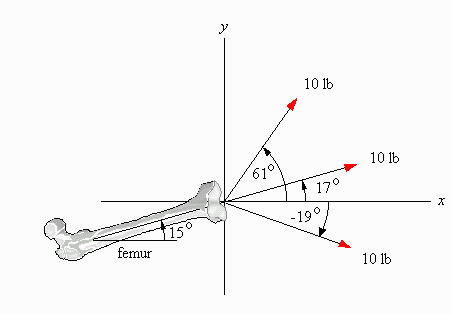Solution
In order to determine the resultant force R, which is a
vector, we have to calculate both its magnitude and its
direction. First, let us compute the magnitude of R. We
accomplish this by resolving each force into its x and
y components, and then summing up all the x
components and summing up all the y components as
follows:
| Force |
x-component |
y-component |
| F1 = 10 lb |
10 cos(-19°) = 10 × 0.9455 = 9.455 |
10 sin(-19°) = 10 ×(-0.3256) = -3.256 |
| F2 = 10 lb |
10 cos(17°) = 10 × 0.9563 = 9.563 |
10 sin(17°) = 10 × 0.2924 = 2.924 |
| F3 = 10 lb |
10 cos(61°) = 10 × 0.4848 = 4.848 |
10 sin(61°) = 10 × 0.8746 = 8.746 |
| Resultant R |
Rx =
23.866 |
Ry = 8.414 |
Since we have calculated the x and y components
of the resultant R, we can find its magnitude by using the
Pythagorean theorem:
R2 = Rx2 +
Ry2 = 23.8662 + 8.4142 = 569.586 + 70.795 = 640.381
which gives us:
R = 25.306 or rounded to 2 significant digits, the same as the
original measurements: R = 25 lb.
The angle of the resultant can be calculated as follows:

From this:

Since the femur had an original orientation of 15° we can conclude that the effect of this
traction system on the femur will be a rise of 4.42°.
